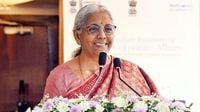Finance Minister Nirmala Sitharaman marked her 66th birthday on Monday, August 18, 2025, a milestone that prompted an outpouring of congratulations from across the nation. The most prominent among the well-wishers was Prime Minister Narendra Modi, who took to the social media platform X to extend his heartfelt greetings. In his message, PM Modi lauded Sitharaman’s unwavering commitment to India’s progress, emphasizing that her efforts are central to realizing the vision of a Viksit (developed) and Aatmanirbhar (self-reliant) Bharat. He concluded with a simple, sincere wish: “Praying for her long and healthy life.”
Sitharaman’s journey to one of the highest offices in India’s government has been nothing short of remarkable. Over the years, she has become a key architect of India’s economic and defense policies, her career marked by a steady ascent through the ranks of public service and government leadership. Now in her third term as a Rajya Sabha member—having been re-elected in July 2022—she stands as one of the most influential figures in Indian politics today.
Her current portfolio is both demanding and prestigious. Since May 30, 2019, Sitharaman has served as the Minister of Finance and the Minister of Corporate Affairs, overseeing the country’s economic strategy, fiscal management, and corporate regulatory framework. Her stewardship of these ministries has been widely acknowledged as instrumental in advancing India’s development goals, particularly as the country pursues ambitious targets for growth and self-reliance.
But Sitharaman’s influence extends well beyond her current roles. She made history as India’s Minister of Defence from September 3, 2017, to May 30, 2019, becoming only the second woman to hold that office after Indira Gandhi. During her tenure, she was tasked with overseeing the modernization of India’s armed forces and managing sensitive defense procurement processes. Her period in the defense ministry coincided with a time of heightened security challenges, and her leadership was seen as both steady and pragmatic.
Before her cabinet-level appointments, Sitharaman’s government service included a range of important positions. From May 26, 2014, to September 3, 2017, she was the Minister of State (Independent Charge) for Commerce and Industry, where she played a pivotal role in shaping trade policy and promoting Indian exports. She also briefly served as Minister of State in the Ministry of Finance and Ministry of Corporate Affairs from May 26 to November 9, 2014, gaining valuable experience that would later inform her work as finance minister.
Her parliamentary journey began in June 2014, when she was first elected to the Rajya Sabha, the upper house of India’s Parliament. She was re-elected in July 2016 for a second term, and again in July 2022, underscoring the confidence her party and colleagues have in her leadership. According to Zee News, even before her entry into Parliament, Sitharaman had already demonstrated her commitment to public service as a member of the National Commission for Women from 2003 to 2005, advocating for gender equality and women’s rights at the national level.
Throughout her career, Sitharaman has been recognized for her sharp intellect, disciplined work ethic, and ability to navigate complex policy issues. Colleagues and observers alike have noted her calm demeanor during high-pressure situations—a trait that has served her well in the often-turbulent world of Indian politics. Her approach to governance is characterized by a blend of pragmatism and vision, qualities that have earned her respect across party lines.
Prime Minister Modi’s birthday message was not merely a formality; it was a public acknowledgment of Sitharaman’s central role in the current government. As reported by Zee Business, Modi praised her for playing “a vital role in realising the vision of a Viksit and Aatmanirbhar Bharat,” a reference to the government’s twin goals of making India a developed nation and fostering economic self-reliance. These themes have been at the core of Sitharaman’s policy agenda, from promoting domestic manufacturing to reforming tax structures and strengthening corporate governance.
Her leadership has been particularly visible during challenging times. As finance minister, Sitharaman has had to steer the Indian economy through the turbulence of the COVID-19 pandemic, global supply chain disruptions, and shifting geopolitical realities. Her budgets have emphasized both fiscal prudence and targeted stimulus, balancing the need for economic growth with the imperative of social welfare. Under her watch, India has launched major initiatives to boost infrastructure, support start-ups, and encourage foreign investment.
Sitharaman’s tenure as defense minister was similarly eventful. She oversaw crucial defense acquisitions and worked to enhance the operational readiness of the armed forces. Her time in the ministry coincided with heightened tensions on India’s borders, and her steady hand was credited with ensuring a measured response to security challenges. According to Zee News, her work in the defense sector “made history” and helped to redefine the role of women in India’s security establishment.
Her earlier role as Minister of State (Independent Charge) for Commerce and Industry also laid the groundwork for many of her later achievements. During this period, she championed the cause of Indian exporters, negotiated trade agreements, and worked to simplify regulatory processes. This experience provided her with a deep understanding of the interconnectedness of global trade and domestic economic policy—knowledge that has been invaluable in her subsequent positions.
Before her rise in national politics, Sitharaman’s service on the National Commission for Women gave her firsthand insight into the challenges faced by women across the country. This early experience informed her later advocacy for greater female participation in the workforce and her support for policies aimed at empowering women economically and socially.
As Sitharaman celebrates her 66th birthday, her career stands as a testament to perseverance, adaptability, and a deep commitment to public service. The widespread recognition she has received—from the highest levels of government to the broader public—reflects both her accomplishments and the trust placed in her leadership. Her ongoing work continues to shape the direction of India’s economic and defense policies, and her influence is likely to endure for years to come.
With the nation’s eyes on her, Nirmala Sitharaman’s journey offers a compelling example of how dedication and vision can drive meaningful change at the highest levels of government. As the country moves forward, her role in guiding India’s future remains as vital as ever.




